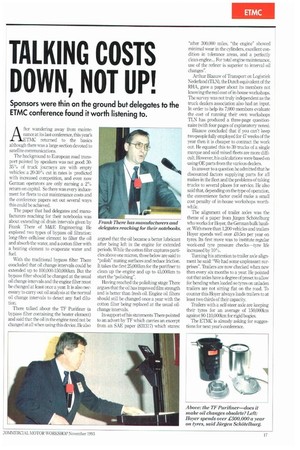TALKING COSTS DOWN, NOT UP!
Page 109

If you've noticed an error in this article please click here to report it so we can fix it.
Sponsors were thin on the ground but delegates to the ETMC conference found it worth listening to.
ALfter wandering away from maintet lance at its last conference, this year's fMC returned to the basics although there was a large section devoted to satellite communications.
The background to European road transport painted by speakers was not good: 3035% of truck journeys are with empty vehicles: a 20-30% cut in rates is predicted with increased competition, and even now German operators are only earning a 2% return on capital. So there was every inducement for fleets to cut maintenance costs and the conference papers set out several ways this could be achieved.
The paper that had delegates and manufacturers reaching for their notebooks was about extending oil drain intervals given by Frank There of M&E Engineering He explored two types of bypass oil filtration: long-fibre cellulose element to filter the oil and absorb the water, and a cotton filter with a heating element to evaporate water and fuel.
With the traditional bypass filter There concluded that oil change intervals could be extended up to 100,000-150,000km. But the bypass filter should be changed at the usual oil change intervals and the engine filter must be changed at least once a ,,ear. It is also necessary to carry out oil analysis at the normal oil change intervals to detect any fuel dilution.
There talked about the TF Purifmer (a bypass filter containing the heater element) and said that the oil in the engine need not be changed at all when using this device. He also argued that the oil became a better lubricant after being left in the engine for extended periods. While the cotton filter captures particles above one micron, those below are said to "polish" mating surfaces and reduce friction. It takes the first 25,000Ion for the purifiner to clean up the engine and up to 45,000km to start the "polishing".
Having reached the polishing stage There argues that the oil has improved film strength and is better than fresh oil. Engine oil filters should still be changed once a year with the cotton filter being replaced at the usual oilchange intervals.
In support of his statements There pointed to an advert by TF which carries an excerpt from an SAE paper (831317) which states:
"after 300,000 miles. "the engine" showed minimal wear in the cylinders, excellent condition in tolerance areas, and a perfectly clean engine._ For total engine maintenance, use of the refiner is superior to interval oil changes".
Arthur Blaauw of Transport en Logistiek Nederland (TLN), the Dutch equivalent of the RI-IA, gave a paper about its members not knowing the real cost of in-house workshops. The survey was not truly independent as the truck dealers association also had an input. In order to help its 7,000 members evaluate the cost of running their own workshops TLN has produced a three-page questionnaire (with four pages of explanatory notes).
Blaauw concluded that if you can't keep two people fully employed for 47 weeks of the year then it is cheaper to contract the work out. He equated this to 30 trucks of a single marque and said mixed fleets are more difficult. However, his calculations were based on using OE parts from the various dealers.
In answer to a question he admitted that he discounted factors supplying parts for all makes in the fleet and the problems of taking trucks to several places for service, He also said that, depending on the type of operation, the convenience factor could make a small cost penalty of in-house workshops worthwhile.
The alignment of trailer axles was the theme of a paper from Jurgen SchOtelburg who works for Hoyer, the German bulk haulier. With more than 1,200 vehicles and trailers Hoyer spends well over £0.5rn per year on tyres. Its first move was to institute regular week-end tyre pressure checks—tyre life increased by 10%.
Turning his attention to trailer axle alignment he said: "We had some unpleasant surprises". Trailers are now checked when new then every six months to a year. He pointed out that axles have a degree of preset to allow for bending when loaded so tyres on unladen trailers are not sitting flat on the road. To counter this Hoyer always loads trailers to at least two thirds of their capacity Trailers with a self-steer axle are keeping their tyres for an average of 150,000km against 90-110,000km for rigid bogies.
The ETMC is already asking for suggestions for next year's conference,




















































































































